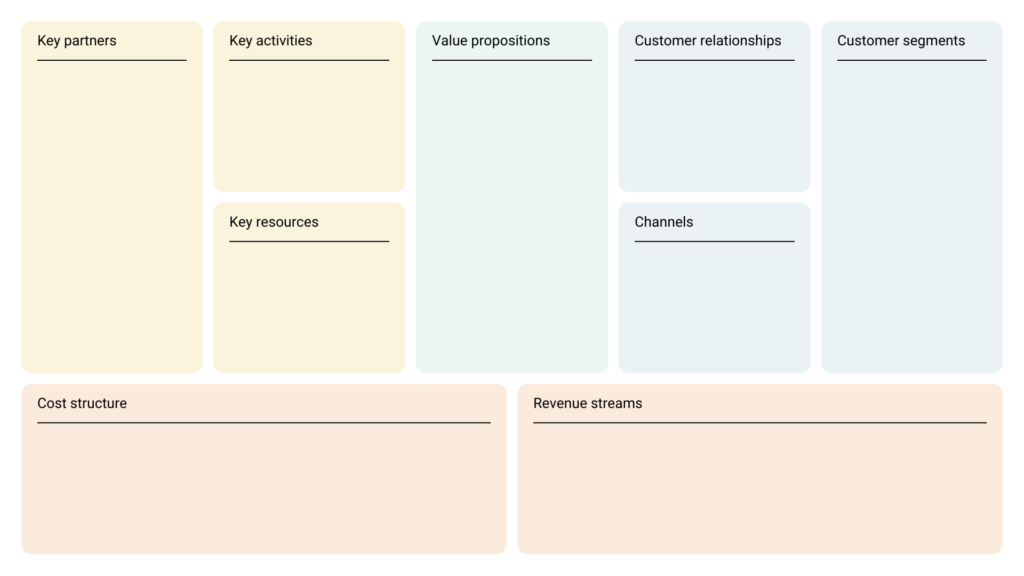Idea work is the foundation of all good business ideas. Once the idea is in place, you can work on the steps that need to be taken before the idea becomes a business or enterprise.

It is important to be ambitious in the conceptual work that will be behind the business or the company. It is not enough on its own but is a good first step, which is then further developed and worked on how it can be developed for the market. When many ideas have come up, it’s good to have someone else to help and review the ideas that have come up. Once a few ideas are in place, the one that is most promising is further explored and worked on.
Various methods to used to brainstorm or develop an idea
What am I good at and what do I like
This first idea is simple and you only need a pen, paper and your imagination.
Step 1: Think and write down 5 things you enjoy doing – what are your hobbies, what do you most want to do in your free time.
Make sure you do not think too much about it, do not think about the business idea right now, just what you like to do.
Step 2: Think and write down 5 things you are good at – what are your main strengths, whether it is to be good with numbers or with incredible endurance.
Step 3: Link the two lists – Now look at your list together and try to link what you like to do, and what you are good at.
If you have problems writing the lists, it may also be good to talk to friends or family and get their perspective and suggestions.

Post-it method
The only thing you need is a bunch of post-it notes, ideally all the same size and shape, and something to write with.

Step 1 – Brainstorm
Here you start to think and put the thoughts onto the Post-it notes. This should be everything you think of regarding your objectives or goals even those that are sett or you already know you want to achieve.
It is important that you only write one thing on your post-it note.
Step 2 – Laying out the post-it notes
Find some big surface and start placing the post-it notes. It is best to do this standing up, and randommly, after more notes come up on the board you will most likley start to see some kind of groups, that you can than start to sort them into groups on the board or table.
If new thoughts come to mind regarding the post-it notes on the board add them, or add new post-it notes.
Step 3 – organizing
Once you have all your post-it notes on the board, you can start to clean up the groupings and making them consistene and adding and removing post-it notes as its needed. If you find post-it notes that you feel don‘t fit, don‘t toss them away, just put them to the side.
Step 4 – Finalizing
Look at all the ideas, evaluate them, and discuss the ideas. Write the ideas down in a more complete form and safe a photo of the board.
This method is good for brainstorming and for groups, as everybody can contribute and it is good to have a discussion afterwards to further developed what you have come up with, or the idea chosen. You can also use this methods online with groups live, where you work similary with post-it notes on the computer.
Site you can test the method on (free at first)
https://miro.com/online-sticky-notes/?
Six hats

This method is good for either individuals or groups in solving problems. The colors of the hats give you a focused point on what to think about or discuss in a group, and the answers to the hats are then used and integrated into the solution or idea.
White Hat: The hat of information
Here it is important to be neurtral and objective. In this hat you look at data, facts, figures and information, regarding your business. Looking at information that you would like to have but do not yet have.
Red Hat: The hat of emotion
This is the inutive view, hunches, gut and feeling. In this hat you have permission to go forward with hunches whithout needing to justify them.
Yellow Hat: The hat of logical positivity
This is the hat were you are allowed to be optimistic, sunny and positive. Here you can write why you think something will work, the savings, the benefits and so forth.
Green Hat: the hat of ideas
This hat is connected to energy, fertility, growth, creativity, and new ideas. This hat should be used to come up with new proposals, suggestions, ideas, alternatives, provocations, and what is interesting as an idea.
Blue Hat: The planning hat
The organizational hat, used for vuilding, managing and concluding the process, including using and the sequenceing use of the other hats.
Black hat: The logical negative hat
In this hat you are careful and cautious, its the judgement hat. The black hat should make you consider the reasons why something may not work, why it may go wrong, or why it is not worth doing. This must be logical and is not a feeling hat.
More information and worksheet on the method:

Business Model Canvas
Is a good way to develop your business model further, or work on the idea you have already had. It is most usefull in helping you transform the simple idea to an organized strategy and good first step before you develop your business plan.
The model gives you an wide snapshot of every aspect of your business plan. Here is an explanation for each box in the Business model canvas as well as a template you can use in your own plan.

Key Partners
These are the individuals or partners that are going to help you new idea/company grow. In most cases there are some things that you will not be able to do or don‘t want to do regarding you business and these are then your key partners. What you need to ask yourself here is what are my partners going to do. The most common partnership are suppliers and buyers.
Value Propostition
This is what your company is making and who are they making it for. This is not about your service or product, but about the need you are fullfilling or a problem you are solving. Once you have established that you can go into listing how your service or product can fullfill these problems.
Cost Structure
This is what it is going to cost you to keep the business running. In this you have to think about everything, it is not just the basic cost, like payroll, rent and materials but all cost should be included here.
Key activites
This is the most important factor of your business, what are you going to do, what is your business. Are you going to sell product, or you consultant who is going to help people solve problems. Your key activities are what you need to become an expert in.
Channels
Your channels are the ways in wich you deliver your product, from your company to your customer. Once upon a time there was only one channel but today there are many more options when it comes to what kind of channels you use for your company.
Customer relationship
This section is how you get your costumer, who is is, how you keep your costumers and how you grow your cosumers. How you do this greatly depends on the type of company/business you are developing.
Revenue Streams
This the various sources from wich you‘r make company/business makes money. This is not how you price your product it is how you catch your revenue streams, sush as sale of goods or the provision of services. The types of revenue depend on the type of activies carried out by the business.
Customer Segments
Knowing who your business is catering to. In this part you figure out who your customer are and why they should buy or use your services. Here it is best to be as specific as you can be for example by figuring out were your costumer lives, what their social habits are, age, gender and so forth.
Key resources
This is what you need to be able to sell your product, that is what do you need to be successfull. This depends on what you are going to do in your company/business. Maybe the most common form of key resources is financing. How much cash do you need to start your business, will you need funding or line of credit. There can also be resources like a stor, manufacturin plant, or delivery truchs and so forth, workforce and so forth.
